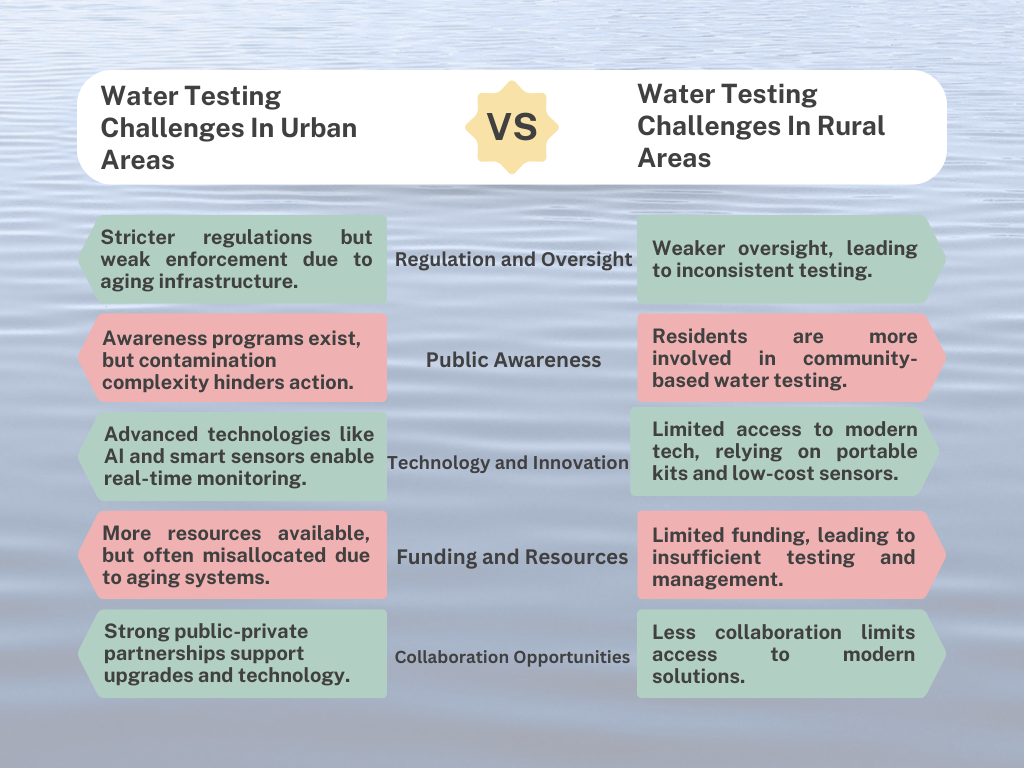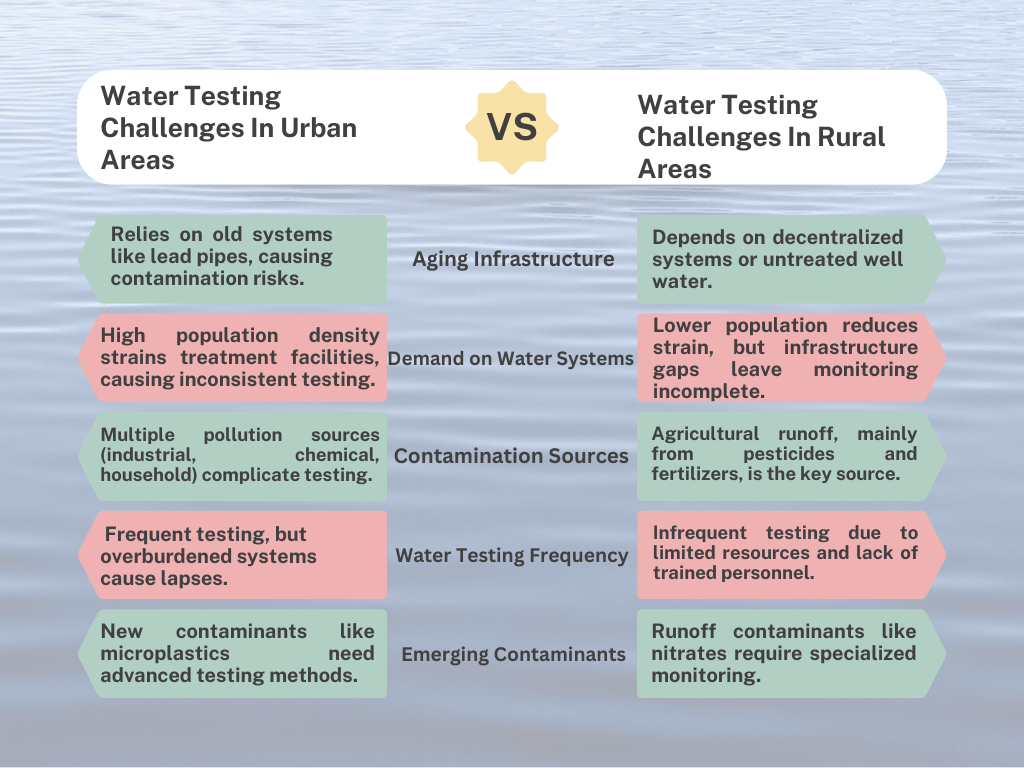Water testing is a critical aspect of ensuring safe drinking water, safeguarding public health, and preserving ecosystems. However, when comparing water testing in urban and rural areas, distinct challenges arise due to differences in infrastructure, resource allocation, and the types of contaminants present. Understanding these disparities is essential for addressing water quality issues and ensuring equitable access to clean water for all communities.
In this article, we will explore the disparities between water testing in urban and rural areas, highlight the key challenges faced by each, and examine innovative solutions that could bridge the gap and improve water quality monitoring everywhere.
Challenges of Water Testing in Urban Areas
Urban areas, with their dense population and extensive infrastructure, face several challenges when it comes to water testing.
Some of the key difficulties include:
1. Aging Infrastructure
Many urban areas rely on old water systems that were built decades ago. These aging systems may include lead pipes, outdated treatment facilities, and sewage systems that are prone to leaks or failures. Despite the technological advances in water testing, aging infrastructure often complicates efforts to ensure water quality. Contaminants like lead or other heavy metals can seep into drinking water through corroded pipes, even in cities that have modern water treatment plants.
Example: In Flint, Michigan, the water crisis that began in 2014 highlighted the dangers of lead contamination due to old infrastructure.
2. High Demand and Overburdened Systems
Urban areas often have a high demand for water due to their population density, leading to overburdened water treatment facilities. The increased stress on these systems can sometimes result in lapses in water quality monitoring and inconsistent testing, particularly during peak usage times. Overworked facilities may also struggle to monitor emerging contaminants like pharmaceuticals, microplastics, or chemicals from industrial runoff.
Example: In densely populated cities, industrial discharges often go unnoticed, adding to water contamination issues.
3. Diverse Contamination Sources
Urban areas generally have a wider range of pollution sources and these include industrial waste, agricultural runoff from nearby areas, household chemicals, and untreated sewage. As a result, water testing must account for a broad range of potential contaminants. The complexity of managing this diversity means that urban water testing programs must constantly evolve to keep up with new and emerging pollutants.
Challenges of Water Testing in Rural Areas
While rural areas may not face the same level of population density and industrial activity as cities, they have their own unique set of water testing challenges:
1. Limited Access to Resources and Technology
Rural communities often lack the resources to implement comprehensive water testing programs. This may include limited access to modern testing equipment, fewer certified labs, and a lack of trained personnel to conduct testing. As a result, rural areas are often underserved in terms of water quality monitoring, with fewer regular testing intervals and less access to real-time data.
Example: In many remote or agricultural communities, water testing is not conducted frequently enough, leading to delays in detecting contamination.
2. Contaminants from Agricultural Runoff
Rural areas, especially those near agricultural operations, are at a high risk for water contamination from pesticides, fertilizers, and animal waste. Runoff from fields can carry these chemicals into nearby water sources, affecting the water quality of streams, rivers, and wells. In some cases, rural communities rely on well water, which is harder to monitor and often goes unchecked for contaminants unless residents invest in private testing.
Example: High concentrations of nitrates in well water have been linked to agricultural runoff, which can cause health problems, especially for infants.
3. Infrastructure Challenges
Many rural areas lack the advanced water treatment infrastructure seen in urban areas. This means that rural communities often depend on decentralized water systems or untreated well water, both of which can be more vulnerable to contamination. Rural areas also struggle with a lack of public funding to invest in water quality management infrastructure.
Example: In rural regions, wells may not be equipped with filtration systems capable of removing hazardous chemicals, leaving residents at risk of exposure to harmful substances.


Disparities Between Urban and Rural Water Testing
The disparities between urban and rural water testing are primarily driven by differences in infrastructure, population density, and available resources. While urban areas benefit from centralized water systems, they often face problems related to aging infrastructure, overburdened facilities, and complex contamination sources. Rural areas, on the other hand, struggle with access to testing resources, infrastructure limitations, and contamination from agricultural runoff.
Innovative Solutions for Water Testing in Urban and Rural Areas
Addressing these disparities requires a combination of innovative solutions, strategic policy changes, and the use of emerging technologies. Below are some potential solutions to improve water testing access and equity across urban and rural areas.
1. Decentralized Water Testing Solutions
Urban: Implementing decentralized water testing systems in urban areas, such as smart sensors installed in households or neighborhoods, can help monitor water quality in real-time. These sensors can detect contaminants such as lead, bacteria, or chlorine levels, sending data directly to municipal authorities for immediate action.
Rural: In rural areas, portable water testing kits and low-cost sensors could provide a more accessible way for individuals to monitor water quality. These tools could be used by households with private wells or by local authorities to regularly test remote water sources.
2. Use of Artificial Intelligence (AI) and Machine Learning
Urban: AI-driven algorithms can analyze water quality data from various sensors and predict potential problems before they occur. For example, machine learning can detect patterns of water contamination or identify unusual changes in water quality that may be linked to infrastructure failures or industrial discharges.
Rural: AI can also help rural communities by analyzing satellite data to detect contamination trends in agricultural runoff or track water quality across vast rural landscapes. This could help prioritize testing in areas most at risk.
3. Community-Based Water Testing Programs
Urban & Rural: Community-based water testing programs, where local residents are trained to conduct basic water tests, can be highly effective. In urban areas, these programs can raise awareness about water safety and empower communities to report contamination. In rural areas, community testing can help fill the gaps where government resources are limited, providing residents with the tools they need to protect themselves and their water sources.
4. Public-Private Partnerships
Urban & Rural: Collaboration between government agencies and private companies can lead to the development of innovative water testing technologies and funding for infrastructure improvements. For example, partnerships could bring smart water sensors to underserved areas or provide grants for water treatment plant upgrades.
5. Improved Regulations and Policy Advocacy
Urban: Strengthening regulatory frameworks to ensure stricter water quality standards, regular testing, and transparency in reporting is vital for urban areas. Policies that mandate frequent inspections of aging infrastructure and the incorporation of modern water quality monitoring technologies would improve safety.
Rural: Policy advocacy for better funding and resources for rural water systems is crucial. This includes providing incentives for rural communities to invest in water testing equipment, offering technical support, and ensuring that government programs prioritize water quality in underserved regions.
Conclusion
While water testing challenges in urban and rural areas differ in several ways, the ultimate goal is to ensure equitable access to clean, safe water for everyone. Urban areas must address issues related to aging infrastructure and diverse contamination sources, while rural communities need more resources and innovative solutions to tackle contamination from agricultural runoff and limited infrastructure.
By leveraging new technologies like IoT, AI, and decentralized testing, both urban and rural areas can move toward more accurate, real-time monitoring systems. With a combination of community engagement, policy improvements, and technological innovation, we can work toward a future where water testing is both accessible and effective, ensuring safe water for all.


Leave a Reply